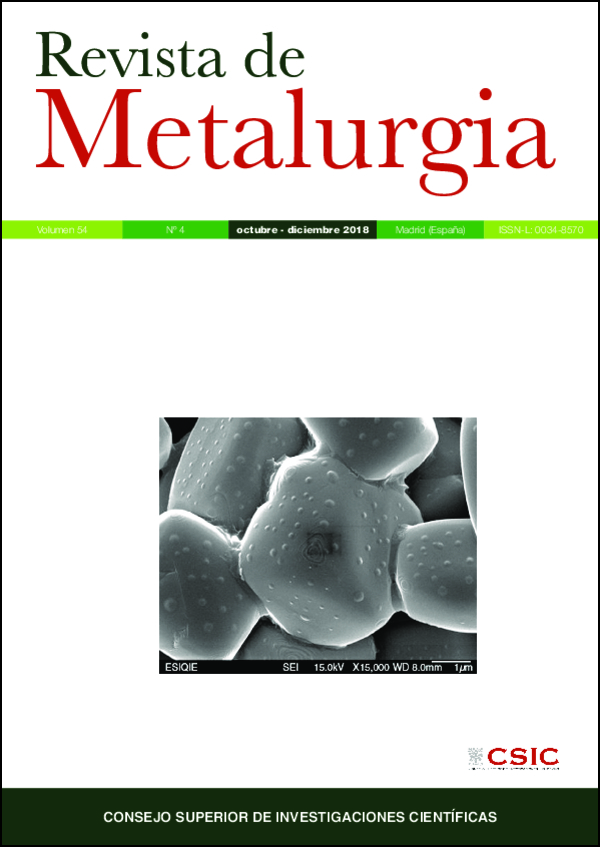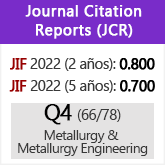La eliminación de metales tóxicos presentes en efluentes líquidos mediante resinas de cambio iónico. Parte VIII: Arsénico(III))/OH-/Dowex 1x8
DOI:
https://doi.org/10.3989/revmetalm.132Palabras clave:
Arsénico(III), Dowex 1x8, Efluentes líquidos, Eliminación, Nanotubos de carbono de pared múltipleResumen
En el presente trabajo se utiliza la resina de intercambio aniónico para la eliminación de arsénico(III) de medios acuosos. Esta eliminación se ha investigado teniendo en cuenta diversas variables experimentales como son: la velocidad de agitación del sistema, la temperatura, el pH de la disolución y la dosificación de resina al sistema. El equilibrio de intercambio aniónico tiene un carácter endotérmico y no espontaneo, en el rango de temperaturas comprendido entre 20 °C y 60 °C, la cinética del proceso responde al modelo de pseudo-segundo orden, sin embargo, el mecanismo de carga del arsénico en la resina cambia en el rango de temperaturas comprendido entre 20 °C y 40 °C. La isoterma de carga del metal en la resina responde al modelo linearizado de Freundlich. Se comparan los resultados de carga de arsénico en la resina Dowex 1x8 con los obtenidos con otras resinas y con nanotubos de carbono de pared multiple. La elución del arsénico se puede realizar con disoluciones acidas, por ejemplo 1 M HCl.
Descargas
Citas
Ahmad, N.F., Kamboh, M.A., Nodeh, H.R., Abd Halim, S.N.B, Mohamad, S. (2017). Synthesis of piperazine functionalized magnetic sporopollenin: a new organic-inorganic hybrid material for the removal of lead(II) and arsenic(III) from aqueous solution. Environ. Sci. Pollut. Res. 24 (27), 21846–21858. https://doi.org/10.1007/s11356-017-9820-9 PMid:28776296
Akartasse, N., Mejdoubi, E., Razzouki, B., Azzaoui, K., Jodeh, S., Hamed, O., Ramdani, M., Lamhamdi, A., Berrabah, M., Lahmass, I. (2017). Natural product based composite for extraction of arsenic (III) from waste water. Chem. Cent. J. 11, article number 33. https://doi.org/10.1186/s13065-017-0261-9 PMid:29086813 PMCid:PMC5389956
Alguacil, F.J., Coedo, A.G., Dorado, T., Padilla, I. (2002). The removal of toxic metals from liquid effluents by ion exchange resins. Part I: chromium(VI)/sulphate/Dowex 1x8. Rev. Metal. 38 (4), 306–311. https://doi.org/10.3989/revmetalm.2002.v38.i4.412
Alguacil, F.J. (2002). The removal of toxic metals from liquid effluents by ion exchange resins. Part II: cadmium(II)/sulphate/Lewatit TP260. Rev. Metal. 38 (5), 348–352. https://doi.org/10.3989/revmetalm.2002.v38.i5.418
Alguacil, F.J. (2003). The removal of toxic metals from liquid effluents by ion exchange resins. Part III: copper(II)/sulphate/Amberlite 200. Rev. Metal. 39 (3), 205–209. https://doi.org/10.3989/revmetalm.2003.v39.i3.330
Alguacil, F.J., López, F.A., Rodriguez, O., Martinez-Ramirez, S., Garcia-Díaz, I. (2016). Sorption of indium (III) onto carbon nanotubes. Ecotox. Environ. Safe. 130, 81–86. https://doi.org/10.1016/j.ecoenv.2016.04.008 PMid:27085001
Alguacil, F.J. (2017a). The removal of toxic metals from liquid effluents by ion exchange resins. Part IV: chromium(III)/H+/Lewatit SP112. Rev. Metal. 53 (2), e093.
Alguacil, F.J. (2017b). The removal of toxic metals from liquid effluents by ion exchange resins. Part V: nickel(II)/H+/Dowex C400. Rev. Metal. 53 (4), e105. https://doi.org/10.3989/revmetalm.105
Alguacil, F.J. (2018a). The removal of toxic metals from liquid effluents by ion exchange resins. Part VI: manganese(II)/H+/Lewatit K2621. Rev. Metal. 54 (2), e116. https://doi.org/10.3989/revmetalm.116
Alguacil, F.J. (2018b). The removal of toxic metals from liquid effluents by ion exchange resins. Part VII: manganese(VII)/H+/Amberlite 958. Rev. Metal. 54 (3), e125. https://doi.org/10.3989/revmetalm.125
ATSDR (2013). Case studies in environmental medicine. Agency for Toxic Substances and Disease Registry, USA. Checked January 2018: www.atsdr.cdc.gov/csem/csem.html.
Babaee, Y., Mulligan, C.N., Rahaman, M.S. (2018). Removal of arsenic (III) and arsenic (V) from aqueous solutions through adsorption by Fe/Cu nanoparticles. Chem. Technol. Biotechnol. 93 (1), 63–71. https://doi.org/10.1002/jctb.5320
Emsley, J. (2005). The elements of murder. A History of Poison. Oxford University Press, Oxford, Great Britain. PMCid:PMC1739363
Flora, S.J.S. (2015). Handbook of arsenic toxicology. Elsevier, Amsterdam, The Netherlands.
Hughes, M.F., Beck, B.D., Chen, Y., Lewis, A.S., Tomas, D.J. (2011). Arsenic exposure and toxicology: a historical perspective. Toxicol. Sci. 123 (2), 305–332. https://doi.org/10.1093/toxsci/kfr184 PMid:21750349 PMCid:PMC3179678
Inaba, K., Haga, M., Ueda, K., Itoh, A., Takemoto, T., Yoshikawa, H. (2017). New Adsorbent for Removal of Inorganic Arsenic(III) from Groundwater. Chem. Lett. 46 (1), 58–60. https://doi.org/10.1246/cl.160768
Kang, Y.G., Yoon, H., Lee, W., Kim, E.J., Chang, Y.S. (2018). Comparative study of peroxide oxidants activated by nZVI: Removal of 1,4-Dioxane and arsenic(III) in contaminated waters. Chem. Eng. J. 334, 2511–2519. https://doi.org/10.1016/j.cej.2017.11.076
Liu, Z., Chen, J., Wu, Y., Li, Y., Zhao, J., Na, P. (2018). Synthesis of magnetic orderly mesoporous alpha-Fe2O3 nanocluster derived from MIL-100(Fe) for rapid and efficient arsenic(III,V) removal. J. Hazard. Mater. 343, 304–314. https://doi.org/10.1016/j.jhazmat.2017.09.047 PMid:28988056
López Díaz-Pavón, A., Cerpa, A., Alguacil, F.J. (2014). Processing of indium(III) solutions via ion exchange with Lewatit K-2621 resin. Rev. Metal. 50 (2), e010. https://doi.org/10.3989/revmetalm.010
Mal'tseva, T.V., Kolomiets, E.A., Vasilyuk, S.L. (2017). Hybrid adsorbents based on hydrated oxides of Zr(IV), Ti(IV), Sn(IV), and Fe(III) for arsenic removal. J. Water Chem. Technol. 39 (4), 214–219. https://doi.org/10.3103/S1063455X17040063
Puigdomenech, I. (2018). MEDUSA (Make Equilibrium Diagrams Using Sophisticated Algorithms) program. Royal Institute of Technology. Sweden. http://www.ke-mi.kth.se/medusa also, https://sites.google.com/site/chemdiagr/. Cheked January 2018.
Roy, P., Dey, U., Chattoraj, S., Mukhopadhyay, D., Mondal, N.K. (2017). Modeling of the adsorptive removal of arsenic(III) using plant biomass: a bioremedial approach. Appl. Water Sci. 7 (3), 1307–1321. https://doi.org/10.1007/s13201-015-0339-2
Schouwenaars, R., Montoya-Bautista, C.V., Isaacs-Páez, E.D., Solís-López, M., Ramirez-Zamora, R.M. (2017). Removal of arsenic III and V from laboratory solutions and contaminated groundwater by metallurgical slag through anion-induced precipitation. Environ. Sci. Pollut. Res. 24 (32), 25034–25046. https://doi.org/10.1007/s11356-017-0120-1 PMid:28920151
Sert, S., Celik, A., Tirtom, V.N. (2017). Removal of arsenic(III) ions from aqueous solutions by modified hazelnut shell. Desalin. Water Treat. 75, 115–123. https://doi.org/10.5004/dwt.2017.20725
Tavakkoli, N., Habibollahi, S., Tehrani, S.A. (2017). Separation and preconcentration of arsenic(III) ions from aqueous media by adsorption on MWCNTs. Arab. J. Chem. 10 (Supp. 2), S3682-S3686. https://doi.org/10.1016/j.arabjc.2014.04.007
Venkatesan, G., Narayanan, S.L. (2018). Synthesis of Fe2O3-coated and HCl-treated bauxite ore waste for the adsorption of arsenic (III) from aqueous solution: Isotherm and kinetic models. Chem. Eng. Commun. 205 (1), 34–46. https://doi.org/10.1080/00986445.2017.1370708
Wang, S., Li, P., Zhang, X., Zheng, S., Zhang, Y. (2017). Selective adsorption of lithium from high Mg-containing brines using HxTiO3 ion sieve. Hydrometallurgy 174, 21–28. https://doi.org/10.1016/j.hydromet.2017.09.009
Yousefsani, B.S., Pourahmad, J., Hosseinzadeh, H. (2017). The mechanism of protective effect of crocin against liver mitochondrial toxicity caused by arsenic III. Toxicol. Mech. Method. 28 (2), 105–114 https://doi.org/10.1080/15376516.2017.1368054 PMid:28812436
Publicado
Cómo citar
Número
Sección
Licencia
Derechos de autor 2018 Consejo Superior de Investigaciones Científicas (CSIC)

Esta obra está bajo una licencia internacional Creative Commons Atribución 4.0.
© CSIC. Los originales publicados en las ediciones impresa y electrónica de esta Revista son propiedad del Consejo Superior de Investigaciones Científicas, siendo necesario citar la procedencia en cualquier reproducción parcial o total.Salvo indicación contraria, todos los contenidos de la edición electrónica se distribuyen bajo una licencia de uso y distribución “Creative Commons Reconocimiento 4.0 Internacional ” (CC BY 4.0). Puede consultar desde aquí la versión informativa y el texto legal de la licencia. Esta circunstancia ha de hacerse constar expresamente de esta forma cuando sea necesario.
No se autoriza el depósito en repositorios, páginas web personales o similares de cualquier otra versión distinta a la publicada por el editor.


















